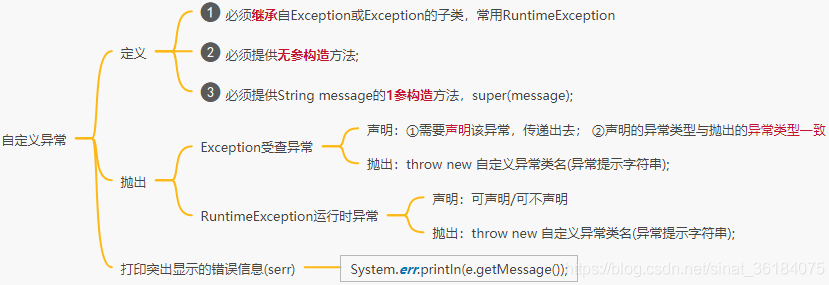1. 自定义异常 1.1 定义方式 ① 必须继承自Exception或Exception的子类 ,常用RuntimeException无参构造 方法;1参构造 方法,super(message);
1 2 3 4 5 6 7 8 9 10 11 12 13 14 15 16 class SexMismatchException extends Exception {public SexMismatchException () {}public SexMismatchException (String msg) {super (msg); class AgeInputException extends RuntimeException {public AgeInputException () {}public AgeInputException (String msg) {super (msg);
1.2 自定义异常的抛出 Exception受查异常(告知调用者使用该方法时必须处理):声明 :①需要声明该异常,传递出去; ②声明的异常类型最好与抛出的异常类型一致抛出 :throw new 自定义异常类名(异常提示字符串);
RuntimeException运行时异常:抛出 :throw new 自定义异常类名(异常提示字符串);
1 2 3 4 5 6 7 8 9 10 11 12 13 14 15 16 17 18 19 20 21 22 23 24 25 26 27 28 29 30 31 32 33 34 35 36 37 38 class Student {private int age;private String sex;public Student () {}public String getSex () {return this .sex;public void setSex (String sex) throws SexMismatchException {if ("男" .equals(sex) || "女" .equals(sex)) {this .sex = sex;else {throw new SexMismatchException ("性别只能为男/女!" );public int getAge () {return this .age;public void setAge (int age) {if (age > 0 && age < 123 ) {this .age = age;else {throw new AgeInputException ("年龄的范围0~123!" );
1.3 自定义异常的捕获
【提示】
1 2 3 4 5 6 7 8 9 10 11 12 13 14 15 16 17 18 19 20 21 22 23 24 25 26 27 28 public class TestDefinedException {public static void main (String[] args) {Student s = new Student ();try {250 ); catch (AgeInputException e) {"运行时异常:" + e.getMessage());catch (Exception e) {try {"嬲" );catch (SexMismatchException e) {catch (Exception e) {
2. 异常中的方法覆盖 声明了异常的方法覆盖注意事项: - 父类/接口
方法名、参数列表、返回值类型必须和父类相同(覆盖的要求 );
父类中方法没有声明异常 ,则子类中也不可以声明异常 ;
父类中方法声明了异常 ,子类重写后可声明也可不声明 ,如果声明则必须是与其相同或其异常子类 ;
子类可以声明比父类更多 的异常,但必须小于 父类的异常类(即异常子类) - 即子类不能抛出比父类更多、更宽的异常 。
父类中的方法有异常抛出的声明,示例:
1 2 3 4 5 6 7 8 9 10 11 12 13 14 15 16 17 18 19 class Super {public void method () throws Exception {"method() in Super" );class Sub extends Super {public void method () throws RuntimeException,ClassNotFoundException {"method() in Sub" );
接口中的抽象方法有异常抛出的声明,示例:
1 2 3 4 5 6 7 8 9 10 11 interface Printable {public void print () throws RuntimeException;class MyClass implements Printable {public void print () throws ArithmeticException, NullPointerException{ }
PS:普通继承和接口的实现,对于异常的使用上没有任何区别。


